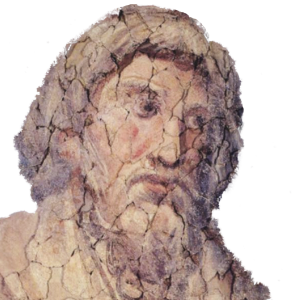Quaere
The New Mithraeum Database
Find news, articles, monuments, persons, books and videos related to the Cult of Mithras
Your search gave 118 results.
-
Monumentum
Altar of the Mitreo della Planta Pedis
The altar includes a slab with an inscription for the salvation of two emperors.TNMM515 – CIMRM 273
Pr(o) sal(ute) Augg(ustorum duorum) / S(oli) i(nvicto) M(ithrae) / [L. ?] Florius Hermadio(n) / sacerdos s(ua) p(ecunia) f(ecit). -
Liber
Mysteria Mithrae (1979)
Proceedings of the International Seminar on the 'Religio-Historical Character of Roman Mithraism, with Particular Reference to Roman and Ostian Sources'. Rome and Ostia 28-31 March 1978 -
Monumentum
Aion relief of Mitreo Fagan
This white marble relief depicting a lion-headed figure from Ostia is now exposed at the Musei Vaticani.TNMM440 – CIMRM 314, 315
C. Valerius Heracles pat[e]r e[t] an[tis]/tes dei iu[b]enis inconrupti So[l]is invicti Mithra[e / c]ryptam palati concessa[m] sibi a M. Aurelio / ---. -
Monumentum
Fresco of procession of grades at Santa Prisca
Procession of figures dressed in different ways with inscriptions calling them by the seven grades of the Mithraic initiation cult.TNMM115 – CIMRM 480
Nama [patribus] / ab oriente / ad occiden[tem] / tutela Saturni; Nama H[eliodro]mis / tut[la]a S[ol]is; Nama Persis / tutela Lunae; Nama l[e]on[i-]b[us] / tutela Iovis; Nama militibus / tutela Mart[is… -
Monumentum
Basin with inscription from Mitreo della Planta Pedis
The dedicator of this marble basin could be the same person who offered the sculpture of Mithras slaying the bull in the Mitreo delle Terme di Mitra.TNMM486 – CIMRM 275
[In]victo Mithrae d(onum) d(edit) M(arcus) Umbilius Criton cum Pyladen vil[ico]. -
Liber
The Cult of Mithras in Late Antiquity. Development, Decline and Demise ca. A.D. 270-430 (2018)
In The Cult of Mithras in Late Antiquity David Walsh explores how the cult of Mithras developed across the 3rd and 4th centuries A.D. and why by the early 5th century the cult had completely disappeared. Contrary to the traditional narrative that the cult… -
Liber
Guida dei mitrei della Roma antiqua. Dai misteriosi sotterranei della capitale. Oro, incenso e mithra (1999)
l Mitraismo è, tra le religioni antiche di epoca romana, quella che più incuriosisce. Il motivo va ricercato nella grande quantità di nessi in comune con il Cristianesimo. Attraverso una attenta analisi, approfondita e assai mirata, Carlo Pavia è rius… -
Syndexios
Quintus Petronius Felix Marsus
Syndexios in Ostia, his name Marsus suggests that he was a snake-charmer. -
Syndexios
Gaius Valerius Heracles
Pater and priest of the Fagan Mithtraeum with several monuments to his name. -
Monumentum
Frescoes with standing figures of Mitreo delle Pareti Dipinte
The frescoes depict several figures dressed in different garments associated with the Mithraic degrees.TNMM104 – CIMRM 268
-
Monumentum
Cautes and Cautópates of Palazzo Imperiale
The sculptures of Cautes and Cautopates from the Mitreo del Palazzo Imperiale may have been reused from an older mithraeum in Ostia.TNMM143 – CIMRM 254, 255
C(aius) Caelius / Ermeros / ant/istes huius lo/ci fecit sua / pec(unia). Posit(a)e XV k(alendas) / febr(u)arias / Q(uinto) Iunio Rus/tico / L(ucio) Plaut[io] / Aquilin[o] / co[(n)s(ulibus)]. -
Monumentum
Inscription of Hermes to Silvanus
This inscription, found in the Mitreo della Planta Pedis, among some other monuments in Ostia, suggests a link between Mithras and Silvanus.TNMM626 – CIMRM 276
Silvano / sancto / sacrum / Hermes / M. Iuli Eunici. -
Mithraeum
Mithraeum of Sarmizegetusa
The large number of monuments found at the Mithraeum of Sarmizegetusa and the sheer size of the temple are unusual.TNMM57 – CIMRM 2027, 2033
-
Syndexios
Hermes
Slave of a certain Macus Iulius Eunicus, Hermes dedicated a monument to Silvanus found in the Mitreo della Planta Pedis.








